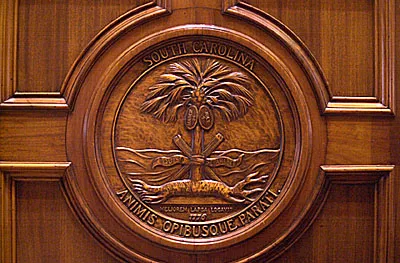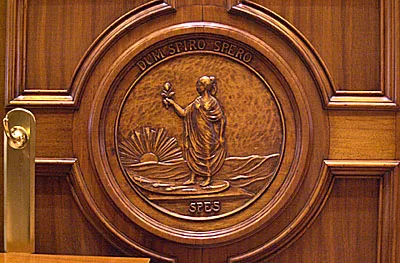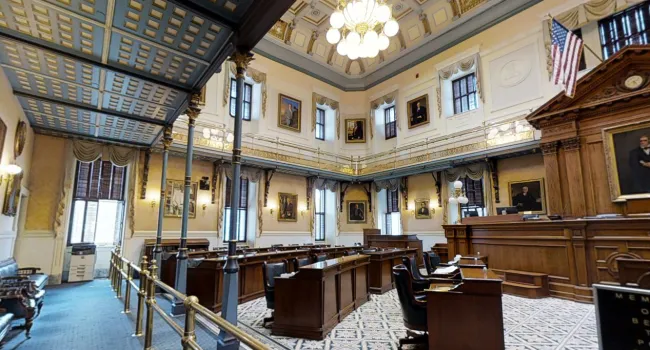The state seal of South Carolina is carved on the front of the Senate desk. An excellent description of the state seal is found in the South Carolina Legislative Manual.
On March 26, 1776, the Provincial Congress of South Carolina set up an independent government, electing John Rutledge as president. On April 2, 1776, the president and Privy Council were authorized by resolution of the General Assembly “to design and cause to be made a Great Seal of South Carolina.”
After independence was declared, a design for the arms of an official great seal, prepared by William Henry Drayton, a member of the Privy Council, was accepted, together with a design for the reverse, said to have been designed by Arthur Middleton. Both designs were turned over to an engraver in Charles Town and engraved as a great seal, which was used by President Rutledge for the first time on May 22, 1777.
The seal was made in the form of a circle, four inches in diameter, and four-tenths of an inch thick. Both the arms (front) and reverse symbolize the battle fought on June 28, 1776, between the unnamed and unfinished fort at Sullivan’s Island (now Fort Moultrie) and the British fleet.
Arms Side: An erect palmetto tree grows on the seashore (symbolic of the fort at Sullivan’s Island that is built on palmetto logs). At its base is a torn-up oak tree, its branches lopped off, representing the British fleet, which was constructed of oak timbers and defeated by the fort’s defenders. Just below the branches of the palmetto are two shields and a pendant; the one on the dexter (left) side is inscribed “March 26” (the date of ratification of the Constitution of South Carolina); the one on the sinister(right) side is inscribed “July 4” (the date of the signing of the Declaration of Independence.) Twelve spears proper are bound crosswise to the stem of the Palmetto, their points raised, (representing the 12 states first acceding to the Union) The band uniting band uniting the spears bears the inscription “Quis Seperabit?” (Who shall separate?) Under the prostate oak is inscribed “Meliorem Lapsa Locavit” (“Having fallen, it has been set up better.”), and below that “1776” appears in large figures (the year the Constitution of South Carolina was passed, the year of the battle at Sullivan’s Island, the year the Declaration of Independence was signed, and the year in which the seal was ordered to be made). At the summit of the exergue, are the words “South Carolina”; and at the bottom “Animis Opibusque Parati” (“Prepared in mind and resources.”).
Reverse Side: A woman walks along on the seashore that is strewn with swords and daggers (typifying Hope overcoming dangers, which the sun, just rising, is about to disclose). In her dexter (left) hand she holds a laurel branch (symbolic of the honors gained at Sullivan’s Island) and in her sinister (right) hand, she holds the folds of her robe. She looks toward the sun, just rising above the sea, indicating that the battle was fought on a fine day, and also bespeaking good fortune. On the upper part is the azure sky. At the summit of the exergue are the words “Dum Spiro Spero” (“While I breathe, I hope.”). Below her image is inscribed “Spes” (“Hope”).



